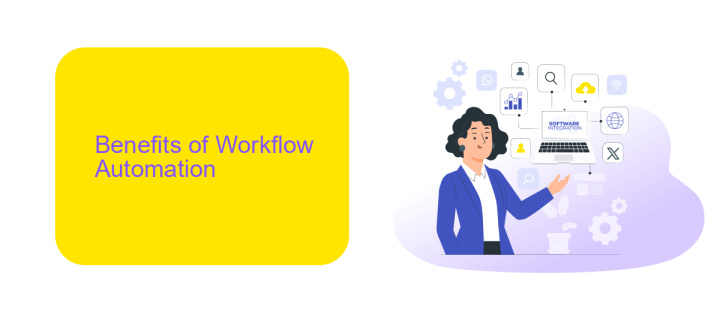Workflow Automation Examples
Workflow automation has become an essential tool for businesses looking to streamline operations, reduce errors, and improve efficiency. By automating repetitive tasks, companies can focus on more strategic activities. In this article, we will explore various examples of workflow automation across different industries, highlighting how these solutions can transform everyday processes and drive productivity gains.
Common Workflow Automation Examples
Workflow automation can significantly enhance productivity by streamlining repetitive tasks. Common examples of workflow automation include:
- Email marketing campaigns: Automatically send personalized emails to customers based on their behavior and preferences.
- Customer support: Use chatbots to handle common inquiries and route complex issues to human agents.
- Data entry: Automatically transfer data between different systems to eliminate manual input and reduce errors.
- Social media management: Schedule and post content across multiple platforms simultaneously.
- Sales processes: Automate lead scoring and follow-up emails to ensure timely engagement with prospects.
These examples illustrate how automation can save time and reduce human error. Tools like ApiX-Drive facilitate seamless integration between various applications, making it easier to set up automated workflows without extensive technical knowledge. By leveraging these tools, businesses can focus more on strategic activities and less on mundane tasks.
Benefits of Workflow Automation

Implementing workflow automation offers numerous benefits for businesses, including increased efficiency and reduced errors. By automating repetitive tasks, companies can save time and allocate resources to more strategic activities. This not only enhances productivity but also ensures consistency in task execution, minimizing the risk of human error. Workflow automation tools can streamline processes across various departments, from marketing to finance, leading to more cohesive and effective operations.
Another significant advantage is the ability to integrate various systems and applications seamlessly. Services like ApiX-Drive facilitate these integrations, allowing businesses to connect different software and automate data transfers effortlessly. This interconnectedness ensures that information flows smoothly between platforms, reducing manual data entry and enhancing data accuracy. Ultimately, workflow automation empowers businesses to operate more efficiently, respond to changes swiftly, and maintain a competitive edge in the market.
Challenges of Workflow Automation

While workflow automation offers numerous benefits, it also presents several challenges that organizations must navigate. Implementing automation can be complex and may require significant time and resources to ensure it operates smoothly and effectively.
- Integration Issues: Integrating various systems and software can be difficult, especially if they are not designed to work together. Services like ApiX-Drive can streamline this process by providing easy-to-use integration tools.
- Data Security: Automating workflows often involves handling sensitive information. Ensuring data security and compliance with regulations is crucial and can be challenging.
- User Adoption: Getting employees to adopt and effectively use new automated systems can be a hurdle. Proper training and change management strategies are essential.
- Maintenance and Updates: Workflow automation systems require ongoing maintenance and updates to remain effective and secure, which can be resource-intensive.
Addressing these challenges requires a strategic approach, careful planning, and the right tools. Leveraging services like ApiX-Drive for seamless integration and investing in robust security measures can help mitigate some of these issues, ensuring a smoother transition to automated workflows.
Best Practices for Implementing Workflow Automation

Implementing workflow automation can significantly enhance efficiency and productivity within an organization. However, to achieve the best results, it is crucial to follow certain best practices. Start by clearly defining your objectives and identifying the processes that will benefit most from automation. This ensures that your efforts are focused and aligned with your business goals.
Next, choose the right tools and platforms that suit your specific needs. For instance, using a service like ApiX-Drive can simplify the integration of various applications and automate data transfers seamlessly. This can save time and reduce errors, making your workflow more efficient.
- Define clear objectives and identify key processes for automation.
- Select appropriate tools and platforms, such as ApiX-Drive, for seamless integration.
- Ensure proper training and support for your team to adapt to new systems.
- Regularly monitor and evaluate the performance of automated workflows.
Finally, continuous improvement is vital. Regularly review and update your automated workflows to ensure they remain effective and aligned with your evolving business needs. By adhering to these best practices, you can maximize the benefits of workflow automation and drive your organization towards greater success.
Future Trends in Workflow Automation
As we move forward, the landscape of workflow automation is expected to see significant advancements driven by artificial intelligence and machine learning. These technologies will enable more intelligent decision-making processes, allowing systems to predict and adapt to changing conditions in real-time. This will not only enhance efficiency but also reduce the likelihood of errors, making automated workflows more reliable and robust.
Another emerging trend is the increasing integration of various tools and platforms through services like ApiX-Drive. Such platforms simplify the process of connecting disparate systems, enabling seamless data flow and communication between different applications. This will empower businesses to create more cohesive and streamlined workflows, reducing the need for manual intervention. As these integrations become more sophisticated, we can expect a future where workflow automation is not just about efficiency but also about creating a more connected and intelligent operational ecosystem.
FAQ
What is workflow automation?
What are some common examples of workflow automation?
How can I start implementing workflow automation in my business?
What are the benefits of workflow automation?
Can small businesses benefit from workflow automation?
Strive to take your business to the next level, achieve your goals faster and more efficiently? Apix-Drive is your reliable assistant for these tasks. An online service and application connector will help you automate key business processes and get rid of the routine. You and your employees will free up time for important core tasks. Try Apix-Drive features for free to see the effectiveness of the online connector for yourself.

